An urban jungle where asphalt once lay. A green zone that welcomes a swirling stream during extreme weather. And a walled park that is also a rain lake deep inside its heart. Copenhagen has spared no expense in recent years to make the city climate-proof. "Why use concrete when you can use greenery?"
© Kris Hendrickx/BRUZZ
| Enghaveparken
Meer weten over het dossier ‘Klimaatbestendige Stad’?
Meer extreme regen en vooral veel meer hittepieken. We weten wat het klimaat in petto heeft de komende jaren en decennia, maar hoe bereid je de stad daarop voor? BRUZZ ging kijken in Wenen en Kopenhagen, twee steden die al heel wat verder staan dan Brussel en kwam terug met een rugzak vol antwoorden. Koelte-oases, de sponsstad, openluchtzwemmen of de wind inzetten als ventilator? Je leest erover in ons dossier ‘Klimaatbestendige Stad’.
Saturday, 2 July 2011. The heavens open over Copenhagen as never before. About two hours of heavy rainfall is all it takes to flood the whole city: besides basements, many houses and streets are inundated, the ramparts of the seventeenth-century castle in the city centre collapse, and traffic on the motorway comes to a standstill before a mass of water. Miraculously, there are no immediate deaths - these only occur because of post-flood illnesses - but the price tag is sobering: 800 million euros. Saturday, 2 July 2011. The heavens open over Copenhagen as never before. About two hours of heavy rainfall is all it takes to flood the whole city: besides basements, many houses and streets are inundated, the ramparts of the seventeenth-century castle in the city centre collapse, and traffic on the motorway comes to a standstill before a mass of water. Miraculously, there are no immediate deaths - these only occur because of post-flood illnesses - but the price tag is sobering: 800 million euros.
Vulnerability to rainwater sends a shock wave through the Danish capital, which is already bracing itself for rising sea and groundwater levels. City council decides things have to change and launches the Cloudburst Management Plan. The plan's comprehensive approach is designed to protect the city from future flooding. The city is well aware that extreme rainfall events will become more frequent.
August 2023. Together with Björn Ginman of SLA Architects, we walk around Sankt Kjelds Plads, until recently an anonymous place in the residential area of Østerbro. "Isn't that a blue tit over there?" asks Ginman. "And there, a great tit!"
"Greenery unleashes something in people, and we city-dwellers need that."
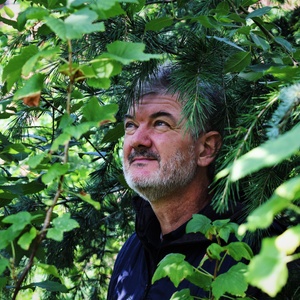
Ten years ago, this was still a big roundabout, spread out like a sea of asphalt, reaching almost to the houses. Today, we stroll along winding paths through a kind of urban forest with a hundred different tree species, mostly native. Over slightly sloping terrain, we pass bees on a flowering bush and fluttering butterflies.
There is still a roundabout in the middle of the square, but as small as technically feasible, allowing two-thirds of the asphalt to be removed. The square's greenery also extends to Bryggervangen, one of the streets leading into the square. Most of the houses overlook a strip of urban rainforest on their doorsteps. The number of parking spaces? It remained the same after the works, at the express request of the residents. Ginman looks around and gloats. "You can disappear into nature here. Greenery unleashes something in people, and we city-dwellers need that.'"
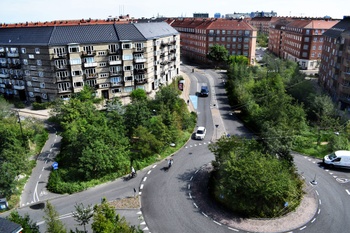
© Kris Hendrickx/BRUZZ
| Sankt Kjelds Plads used to be a roundabout that reached up to the houses. Two thirds of the asphalt gave way to 600 trees of 100 different species.
Nature - including the dead trees which can just remain here - gets all the attention in the new Sankt Kjelds Square. But the main reason for the redevelopment was to make the area more resilient to the next flood. "Rainwater from all the houses around the square is channelled into the greenery," our guide explains. "The vegetation already absorbs a lot of water, but the rain is also directed to areas where it can soak or, if necessary, form a pond. In addition, the various green areas are connected to each other so that we can slow down the rainwater as much as possible. (Suddenly) Ha, a pigeon's nest!" Ginman pulls out his smartphone to take a picture of the nest a good metre away.
Rock 'n' roll project
The banal roundabout of yesteryear has now become an attraction. Not only for the customers of the new café on the square, but also for visitors who take a seat on one of the few benches in the green. Katrin (61) and Derek (68) stop there on their bike ride through town. "You can just look at the trees and relax," says British Derek, "as long as you don't have to answer any silly questions from journalists (British grin).”
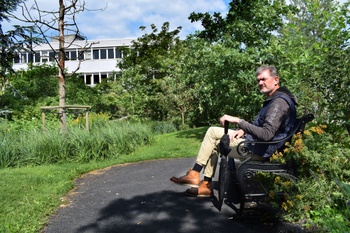
© Kris Hendrickx/BRUZZ
| Architect Bjørn Ginman at Sankt Kjelds Plads: 'Here you can disappear into nature.'
But city councils and planners from far and wide are also coming to visit. "This is therefore a rock'n'roll project like no other anywhere," says architect Ginman. "I have already shown it to the Chinese, the Brazilians, the Australians and the New York City Council. People suddenly want to live here. Rents have risen dramatically.”
For Copenhagen city planner Jan Gehl, whom we visit at his home in the suburbs, the forest square is even a bit too rock’n’roll. "Maybe there are a bit too many trees, I miss the places where people can meet," he says.
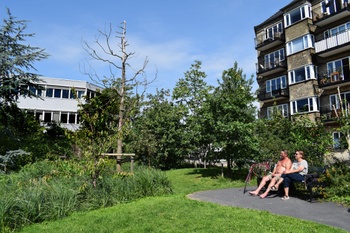
© Kris Hendrickx/BRUZZ
| Katrin and Derek planned their break at Sankt Kjelds Plads. 'You can look at the trees here and relax.'
Sankt Kjelds Plads is the heart of the Klimakvarter: the climate district, full of experimentation with urban planning adapted to changing weather patterns. And the urban jungle nicely demonstrates the philosophy of Copenhagen's approach: where there is no other option, rainwater goes to new mega sewers and storm drains. But wherever possible, the city opts for above-ground redevelopment with greenery. That way, you can slow down rainwater while scoring on other fronts. "You can spend the same money twice or three times," to quote Gehl again. A new or renewed green meeting space is created, urban biodiversity benefits from it and the new vegetation also cools down the city. After all, even northern Denmark deplored at least 250 heat deaths in 2018.
The Cloudburst plan is not limited to Sankt Kjelds: between 2015 and 2035, 300 places will get such a green and climate-proof redevelopment. 17 of these have already been completed, and another 59 are in the pipeline.
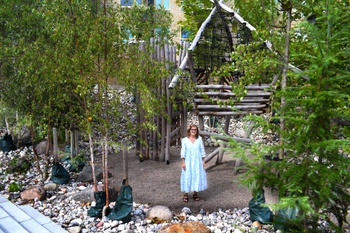
© Kris Hendrickx/BRUZZ
| Lene Andersen in one of the climate gardens supported by the city. 'Even without rain, this is a fantastic space.'
"If there's one thing I'm proud of, it's that we have such a comprehensive master plan that all new developments in the city fit into. It makes little sense to start separate projects here and there," says Jan Rasmussen from the city's Climate Adaptation Centre, as he shows us around another recently completed green space: Karens Minde. The swampy and neglected park of yesteryear is now a modern green space, including a stylish playground.
The eye-catcher of the park? A meandering riverbed, partly paved and partly green. The paved section can be used as a play area for youngsters, while the green section forms a valley of flowers. In the event of a cloudburst, the riverbed slows down the water and directs it to a small lake at the end of the park. Does the water get too high there too? Then there is a large rain pipe that drains the excess water to the sea.
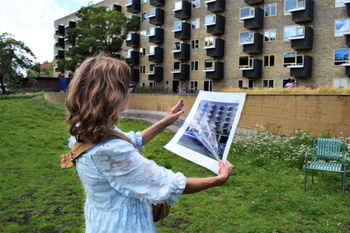
© Kris Hendrickx/BRUZZ
| Lene Andersen toont ons een groot wooncomplex met 220 appartementen: het regenwater van het hele gebouw wordt naar verschillende insijpelzones geleid.
Playground becomes pond
Making public spaces climate-friendly is all well and good. But the city is more than that. That is why the master plan also involves homeowners. Lene Andersen shows us two such projects. In the north of Copenhagen, we walk past a large housing complex with 220 flats. Andersen shows how rainwater from the whole building is directed to different infiltration zones. One is a playground with natural stones, reminiscent of a riverbed in the south of France. During heavy rain, the playground can fill up. A little further on, the rain is diverted into a garden with space for a pond and an underground water buffer. "As far as I know, there has never been much water on the surface. So it works as intended: primarily as a fantastic green space for the residents.”
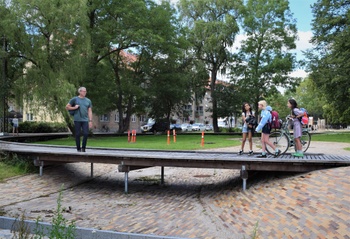
© Kris Hendrickx/BRUZZ
| Jan Rasmussen in the green bed of Karens Minde: 'I am proud of our master plan. Starting separate projects makes little sense.'
Projects on private land can seem like a drop in the ocean, says Andersen. And with ten completed projects and 4,000 square metres, they are still a drop in the ocean. On the city's radar, however, there are another 300 projects totalling more than a million square metres. What helps here is the scale of housing construction in Copenhagen. There are far fewer houses for one family or a few families here than in Brussels, but large ensembles all the more.
Multi-stage rocket
"Just use greenery instead of concrete", it sounds too good to be true. And it is. Because trees and floodable green spaces are far from sufficient everywhere in the Danish capital. We see this when we head to Enghaveparken, a historic park in increasingly trendy Vesterbro. It is a park with many faces: while a nearby school holds its gymnastics lessons in the rose garden, two senior citizens have taken a seat on the low wall surrounding the park with bottles of beer. By the central pond, a group of kindergarten children are passing by in XL prams. And on the stands of the sports field, a group of schoolchildren on a field trip are taking a break. A park full of life.
If Sankt Kjelds Plads is a rock 'n' roll project where nature takes its course, perhaps the revamped Enghaveparken is best compared to a multi-stage rocket in the fight against flooding. This is how it works: during normal rainfall, rainwater from the surrounding neighbourhoods flows into the pond and a new water reservoir under the rose garden. In the event of excessive rainfall, which occurs every one to ten years, the concrete sports field also floods. Next is the rose garden's turn. And finally, if the weather gods strike out again like in 2011, as they do only once in a hundred years, the entire park becomes one big walled pond. "At that point, a barrier will come out of the ground here, closing off the concrete wall around the park," explains architect Flemming Rafn of Tredje Natur.
At 16 million euros, the climate-proof redevelopment of Enghaveparken was not exactly cheap. But then the park's water capacity, at 22,000 cubic metres, is enormous. "Do you know the Waterplein in Rotterdam, that floodable sports field? Our park has more than ten times that capacity," says Rafn. Yet another benchmark: the storm basin under Place Flagey, the second largest in Brussels, can handle 33,000 cubic metres, but did cost 40 million euros in the early 2000s.
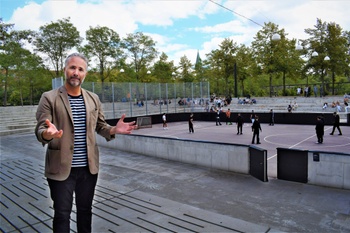
© Kris Hendrickx/BRUZZ
| Architect Flemming Rafn voor het overstroombare sportveld in Enghaveparken, één van de etappes bij het vollopen van het park met regenwater.
The city council makes the case that the procedure is not a luxury. After all, unlike Sankt Kjeldsplein, the park is located at the foot of a hill. "Currently, rainwater from several blocks of houses around it already flows into the park," explains the architect. "But gradually more and more areas will send their rainwater here by disconnecting it from the sewer system. Eventually, the park will receive water from an area about 20 times its size."
As with Sankt Kjelds Plads, the local residents were involved in the new Enghaveparken. "For example, they made sure that there was a café in the entrance pavilion, so that there was social control over the park," Rafn recalls. The neighbourhood's commitment sometimes went far. "At one point, the concrete wall around the park had to remain grey in order to save money. The residents called the newspapers and screamed bloody murder about the ghetto atmosphere it would create. So as you can see, we now have a lovely sand-coloured wall.”
"Uiteindelijk zal het park water ontvangen van een gebied dat circa twintig keer zo groot is als zijn eigen oppervlakte"
Too expensive
The approach in Enghaveparken shows that there is still quite a bit of concrete used in the Danish capital. A necessity for some, an excessive investment for others. "We are now constructing the city for those 'once in a hundred years catastrophes' expected by 2100," sighs Anders Jensen of Miljøpunkt Nørrebro, a local environmental organisation. "This is extremely expensive and also emits a lot of CO2." Jensen, who himself has a degree in climate adaptation, argues for much more small-scale, local solutions with less concrete. "The problem is also that many large-scale projects are so expensive that you cannot implement these solutions on the scale of the whole city."
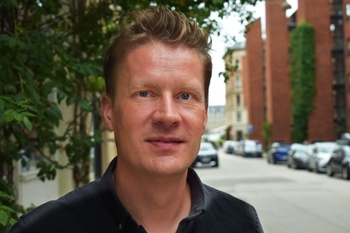
© Kris Hendrickx/BRUZZ
| Anders Jensen van Miljøpunkt Nørrebro, pleit voor veel meer kleinschalige, lokale oplossingen met minder beton.
Jensen is not alone in his analysis. "We now have these pearls, these spectacular projects," says Copenhagen master builder Camilla van Deurs elsewhere in this issue (see p. 17). "It's now a question of linking them together in a necklace through less spectacular interventions."
We return briefly to Sankt Kjelds Plads. Architect Ginman is admiring a dead tree that just remains there. "It's kind of beautiful, isn't it?" He doesn't think his square is expensive at all. "Four million euros for such a big project I would rather call cheap. And you have to start somewhere if you want to save the world."
Read more about: Brussel , Milieu , Gezondheid , Klimaatbestendige stad , Kopenhagen , klimaatverandering
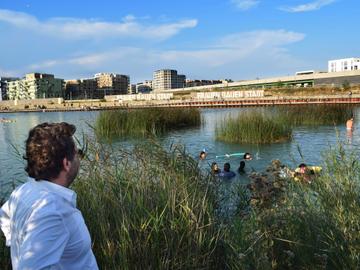
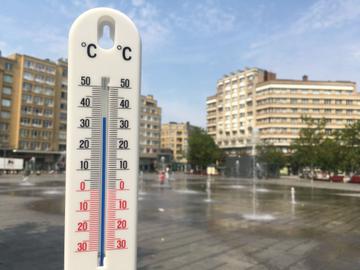


Fijn dat je wil reageren. Wie reageert, gaat akkoord met onze huisregels. Hoe reageren via Disqus? Een woordje uitleg.